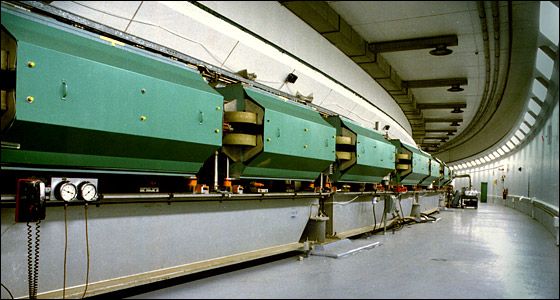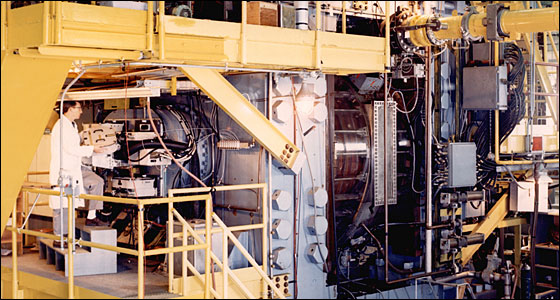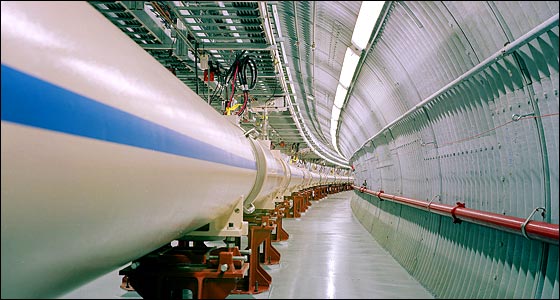Stop 3
Alternating Gradient Synchrotron

Brookhaven Laboratory’s Collider-Accelerator Department is based in the building in front of you. Members of the Collider-Accelerator Department use particle accelerators and push subatomic particles, such as electrons and protons, to a point close to the speed of light and work with Brookhaven’s Physics Department and others to develop, improve, and operate experiments. Do you see that large, blue, C-shaped magnet in front of the building? That’s from the Cosmotron.
Behind Bldg. 911 is the Alternating Gradient Synchrotron, which has been one of the world's premier particle accelerators since operations began in 1960. During the last 50 years, researchers at the AGS have earned three Nobel Prizes for Physics and the facility is still crucial to experiments at Brookhaven today.
The AGS is a circular particle accelerator just shy of a half-mile across. Inside, 240 magnets alternate forces inward and outward one after the other, propelling and focusing protons and heavy ions. This concept of the alternating gradient, or strong-focusing principle, was developed by Brookhaven physicists to accelerate protons to energies that would have been otherwise unachievable. The strong-focusing principle is also the basis for many other accelerators today.
Bubble Chambers
 Two of the most famous early detectors used at the AGS to study the phenomena of the day were the
80-inch and the
7-foot bubble chambers. In the 80-inch bubble chamber,
researchers proved the existence of a particle called omega minus. You can see both chambers on permanent display
outside the Workforce Development and Science Education Office at Bldg. 438 across Brookhaven Avenue from Berkner Hall.
Two of the most famous early detectors used at the AGS to study the phenomena of the day were the
80-inch and the
7-foot bubble chambers. In the 80-inch bubble chamber,
researchers proved the existence of a particle called omega minus. You can see both chambers on permanent display
outside the Workforce Development and Science Education Office at Bldg. 438 across Brookhaven Avenue from Berkner Hall.
Today, the AGS accelerates heavy ions for experiments to determine the biological effects of cosmic radiation at the NASA Space Radiation Lab. It also injects heavy ions into the Relativistic Heavy Ion Collider, or RHIC. RHIC is a 2.4-mile crash course for particles propelled through magnets like the one you saw outside the Superconducting Magnet Division.
RHIC
 Colliding gold ions, RHIC has
produced a freely flowing liquid composed of quarks and gluons. At four-trillion degrees
Celsius, 250,000 times hotter than the center of the sun, this quark-gluon plasma is some of the hottest matter ever
created in a laboratory — and acts like the world's most “perfect liquid.” This was a stunning finding for RHIC scientists,
who are studying what the universe may have looked like in the first few moments after its birth to understand more about
why the physical world works the way it does — from the smallest subatomic particles to the largest stars.
Colliding gold ions, RHIC has
produced a freely flowing liquid composed of quarks and gluons. At four-trillion degrees
Celsius, 250,000 times hotter than the center of the sun, this quark-gluon plasma is some of the hottest matter ever
created in a laboratory — and acts like the world's most “perfect liquid.” This was a stunning finding for RHIC scientists,
who are studying what the universe may have looked like in the first few moments after its birth to understand more about
why the physical world works the way it does — from the smallest subatomic particles to the largest stars.


